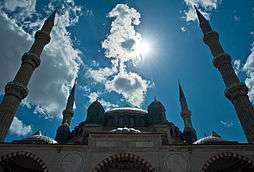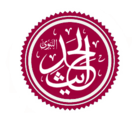Shama'il Muhammadiyah
The Shamā'il Muhammadiyyah ("The Appearance of Muhammad"), often referred to as Shamā'il al-Tirmidhi or simply Shamā'il), is a collection of hadiths compiled by the 9th-century scholar Tirmidhi regarding the intricate details of the Islamic prophet Muhammad's appearance, belongings, manners and life. The book contains 399 narrations from the successors of Muhammad which are divided into 56 chapters.[1]
The best known and accepted of these hadith are attributed to Muhammad's son-in-law and cousin Ali.[2] Another well-known description is attributed to a woman named Umm Ma'bad.[3] Other descriptions are attributed to Aisha, `Abd Allah ibn `Abbas, Abu Hurairah and Hasan ibn Ali. While shama'il lists the physical and spiritual characteristics of Muhammad in simple prose, in hilye these are written about in a literary style.[4] Among other descriptive Shama'il text are the Dala'il al-Nubuwwah of Al-Bayhaqi, Tarih-i Isfahan of Abu Naeem Isfahani, Al-Wafa bi Fadha’il al-Mustafa of Abu'l-Faraj ibn al-Jawzi and Al-Shifa of Qadi Ayyad are the main shemaa-il and hilya books.[4]
An Urdu translation and commentary, Khasa'il-i Nabawi was written by Muhammad Zakariya al-Kandahlawi.
An English translation and commentary, "A Commentary on the Depiction of Prophet Muhammad" was published in 2015.
Content of descriptions
The description of Muhammad by Ali, according to Tirmidhi, is as follows:[5]
[It is related] from ‘Ali (may God be pleased with him) that when he described the attributes of the Prophet (may the blessings of God and peace be upon him), he said: "He was not too tall, nor was he too short, he was of medium height amongst the nation. His hair was not short and curly, nor was it lank, it would hang down in waves. His face was not overly plump, nor was it fleshy, yet it was somewhat circular. His complexion was rosy white. His eyes were large and black, and his eyelashes were long. He was large-boned and broadshouldered. His torso was hairless except for a thin line that stretched down his chest to his belly. His hands and feet were rather large. When he walked, he would lean forward as if going down a slope. When he looked at someone, he would turn his entire body towards him. Between his two shoulders was the Seal of Prophethood, and he was the last of the prophets."
The description attributed by Umm Ma'bad goes as follows:[3]
I saw a man, pure and clean, with a handsome face and a fine figure. He was not marred by a skinny body, nor was he overly small in the head and neck. He was graceful and elegant, with intensely black eyes and thick eyelashes. There was a huskiness in his voice, and his neck was long. His beard was thick, and his eyebrows were finely arched and not joined together. When silent, he was grave and dignified, and when he spoke, glory rose up and overcame him. He was from afar the most beautiful of men and the most glorious, and close up he was the sweetest and the loveliest. He was sweet of speech and articulate, but not petty or trifling. His speech was a string of cascading pearls, measured so that none despaired of its length, and no eye challenged him because of brevity. In company he is like a branch between two other branches, but he is the most flourishing of the three in appearance, and the loveliest in power. He has friends surrounding him, who listen to his words. If he commands, they obey implicitly, with eagerness and haste, without frown or complaint.
| |
|---|
 |
|
Lists |
|
|
Muhammad's title as the "seal of the prophets" (khātam an-nabīyīn خاتم النبيين ; i.e. the last of them, as it were the "seal" closing God's communication to man) is taken from Ali's description,
- "Between his two shoulders was the seal of prophethood, and he was the seal of the prophets"
This "seal of prophethood" (khātam an-nubuwwah خاتم النبوة ) between Muhammad's shoulders is given a closer description in other texts of the hadith, and it is given a dedicated discussion in Sahih Muslim. It is depicted as a mole on the end of his left shoulder blade, in size compared to a pigeon's egg or an apple.[6] A passage from Sunan Abu Dawood (32.4071), also collected in the Shama'il, reports how one Qurrah ibn Iyas al-Muzani on the occasion of swearing allegiance to Muhammad put his hand inside his shirt to "feel the seal".[7]
See also
References
- ↑ ibn Isa (2011)
- ↑ Brockopp, Jonathan E. (2010). The Cambridge companion to Muhammad. Cambridge University Press. p. 130. ISBN 978-0-521-71372-6.
- 1 2 Ernst, Carl W. (2004). Following Muhammad: Rethinking Islam in the Contemporary World. UNC Press Books. pp. 76–78. ISBN 978-0-8078-5577-5.
- 1 2 Erdoğan, M. (2007). "Hâkim Mehmed Efendi'nin Manzum Hilyesi" (PDF). Cumhuriyet Üniversitesi İlahiyat Fakültesi Dergisi (in Turkish). 11: 317–357.
- ↑ Shick, I.C. (2008). "The Iconicity of Islamic Calligraphy in Turkey". RES: Anthropology and Aesthetics (53/54): 211–224. JSTOR 25608818.
- ↑ Sahih Muslim, trans. Abdul Hamid Siddiqui, "The Book Pertaining to the Excellent Qualities of the Holy Prophet (may Peace be upon them) and His Companions (Kitab Al-Fada'il)", chapter 28: "the fact pertaining to the seal of his prophethood, its characteristic feature and its location on his body". See also Sam Shamoun, Muhammad and the Seal of Prophethood: A Sign or A Physical Deformity?
- ↑ "Narrated Qurrah ibn Iyas al-Muzani: I came to the Apostle of Allah (peace_be_upon_him) with a company of Muzaynah and we swore allegiance to him. The buttons of his shirt were open. I swore allegiance to him and I put my hand inside the collar of his shirt and felt the seal." online edition. The original context is a discussion of the clothing, the point being made is that al-Muzani was able to put his hand inside the shirt's collar as Muhammad kept his collar open.
- ibn Isa, Muhammad (Imam Tirmidhi) (2011). Syama'il Muhammadiyah: KeanggunanMu Ya Rasulullah (Hardcover) (in Arabic and Malay). Malaysia: PTS Islamika Sdn. Bhd. p. 388. ISBN 978-967-3-66064-3.
External links
- Shamail Tirmidhi - English translation with Arabic chapters
